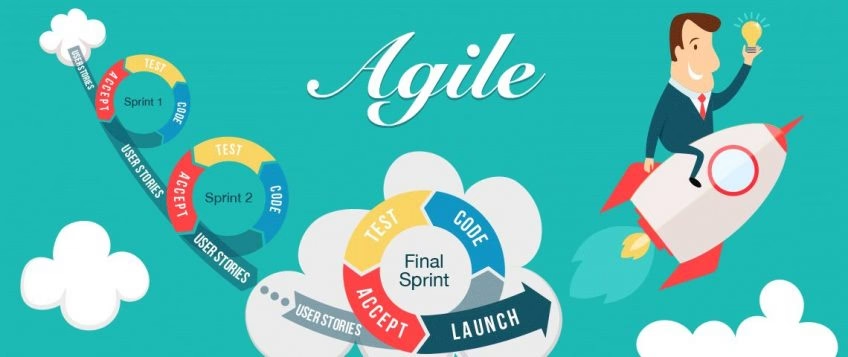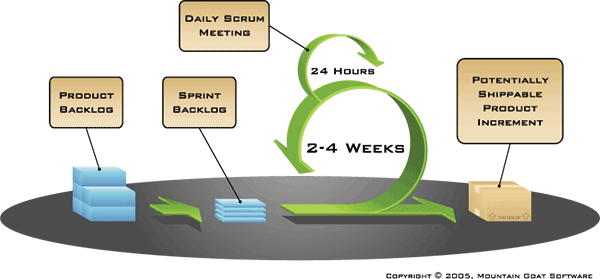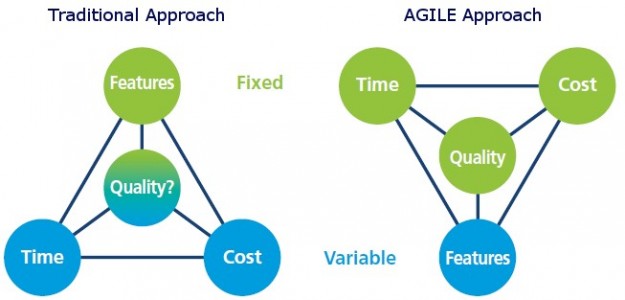
How Can Agile Help with Change Management?
Interested in 5 ways Agile can help with change management?
You've come to the right place.
According to a study, 70% of organizational transformations fail. In most cases, the reason for failure is that the human aspect of the transformation wasn't well managed.
Agile can help with this.
A brief overview of change management
No organizational transformation can be successful simply by focusing on the technological side. While a new enterprise resource planning ERP model is indeed nice, it is possible that no one may even use it.
Likewise, a new automation process may be wonderful, but it will not provide any benefit unless people use it. Change management is the essential link between the new technology and the gains that an organization will feel.
Change management deals with the people side of an organizational transformation. It allows the people in the organization to see the benefits, thereby making them understand the compelling reason for the change, and also preparing them for the change.
It is the set of processes, methods, tools, and activities that take an organization from a ’current state' to a ’desired state'. The objective of change management is to bring in a sustainable change in the behavior of people in the organization.

Get a complimentary discovery call and a free ballpark estimate for your project
Trusted by 100x of startups and companies like
They were using the "A" set of processes methods tools earlier and were getting a "B" set of results. After the change management, they will consistently use an "X" set of processes-methods-tools and get a "Y" set of results.
Read more about it in "What is change management?”.
Many perceive the accompanying activities or tools as change management. For e.g., a new tool, a new document, meetings, training sessions, mass email communications, etc. are often seen as change management. These are not "change management", though. At best, they are components of change management.
Read "Change management is this…not that” to know what is and what is not change management.
How do organizations cope with managing change? Sadly not too well.
Do we have any new ways to aid organizational change management? It turns out that we do.
Agile methodology can improve the success rate of organizational transformation projects.
In this article, I will describe how an agile change management process can do this and what the benefits are as compared to traditional change management.
Stages of organizational change
The organizational change goes through stages. These are as follows:
- Initiation: This is when a few people in the organization realize that something is amiss. The organization isn‘t working as it should. The triggers for this realization could be sub-optimal business results, however, even internal issues can give rise to this. People at any level in the organization can get this feeling.
- Investigation: This is the next step when people start to analyze options. They create a vision or a ’To-be picture' of the organization. They also assess the readiness of the organization to embrace a change.
- Intention: Strategizing and planning take place in this stage. Note that the vision must include a visible change in the organizational culture.
- Introduction: This is when the change is announced to the people. The senior-most leaders in the organization must champion the change. They must get buy-in from the people. The leaders must do this by painstakingly answering questions from people and providing clarity to them. No shortcut is possible. Leaders must set expectations clearly.
- Implementation: This is when the organizational processes, tools, and methods change to support the transformation. People's behavior must change. Leaders must recognize people that change their behavior and coach the ones that aren‘t changing.
- Integration: This is the stage when the organization successfully integrates the change in its systems, processes, tools, methods, and overall culture. Letting up at this stage can take the organization back to the earlier days, thus making the change futile.
Read more about the change management stages in “Change management stages”.
Why change management often fails?
Experts cite many reasons for the failure of change management, however, some of them are merely symptoms. The key reasons for the failure of organizational change management are the following:
- Lack of organizational alignment: A successful change management requires the stakeholders‘ alignment. If stakeholders don‘t unanimously agree with the change, it fails. This requires more than logical alignment. Emotional attunement is more important. The stakeholders must feel the urgency of the change at the gut level.
- Inadequate commitment: Unless the senior-most executive in the organization demonstrably champions the change, the change management project will fail. However, if there's no grassroots level commitment, even then it will fail too. Complete commitment to the change is imperative for successful change management.
- Unsuitable processes, methods, and tools (PM&T): Using the right technology and project management tools help in the success of change management. A wrong choice of PM&T pushes it towards failure since it can‘t handle the complexity.
Read “3 reasons for change management project failure" for more information on these key reasons. Other reasons, e.g., insufficient training, change agents plowing a lonely furrow, etc. are all manifestations of one of the above.
What is Agile?

Before I explain how Agile can help change management, let‘s briefly see what Agile is. Agile is a methodology. There are many reasons why it emerged. However, the broad reason is that business as we once knew, has changed.
The pace of innovation is now rapid. Had businesses stuck to the old methods, they would “miss the bus”.
Earlier methods like ’Waterfall' conceptualized a project, defined its' requirements, and then planned it. The project execution and tracking followed. There was a significant time lapse between the project conceptualization and the actual implementation.
This worked earlier since the pace of innovation was slower.
However, nowadays, innovation is fast-paced. An organization relying on the ’Waterfall‘ method may find after the project implementation that new technologies have made the project irrelevant! This gave rise to a new methodology that emphasized iterative development.
The organization will release new features frequently. They will keep getting the market feedback, and course-correct when needed.
That new methodology is Agile. It focuses on a continuous iteration of development and testing. These iterations continue throughout the project lifecycle. Read more about it in “Agile model & methodology: a guide for developers and testers”.
The above definition is geared more towards software development, but that‘s just an example. Agile is a philosophy. Its‘ application is possible in many industries and use-cases. Agile concepts like backlog, sprint, cross-functional teams, and timeboxing can apply to many other industries.
Read “Apply agile methodology to non-software enterprise projects” for more insights.
The Agile approach to change management

Let‘s now see how Agile can help change management. I will identify the Agile principles that matter and relate how they can aid change management.
1,200 top developers
us since 2016
Proactively seek out change for the greater value
Remember that iconic book “Who moved my cheese” by Dr. Spencer Johnson? Organizations will need to change. It‘s inevitable. Proactively monitoring the environment, studying the signals, and boldly seeking out the change make an organization nimble.
The Agile principle in consideration here is “Welcome changing requirements, even late in development. Agile processes harness change for the customer's competitive advantage.” Read “The 12 Agile manifesto principles simply explained” for details.
How will it translate to organizational change management? The key here is to not confine the organization to a rigid change approval process. The core of the organization should remain unaltered forever.
However, everything around the core can change according to market requirements. The management guru Jim Collins explains it succinctly in “Preserve the core/stimulate progress”.
The Computing-Tabulating-Recording Company (C-T-R), founded in 1911, was making computing scales and time clocks in 1911. It‘s the same company that has now built TrustChain, i.e., a consortium between themselves and jewelry giants.
This is for jewelry supply chain assurance using cutting-edge blockchain technology. The company is IBM, and you can look up their early history here.
IBM retained its‘ core. As the noted management guru Tom Peters had said about them, it‘s a services company. However, it changed everything else, by anticipating what technology evolution the market needs.
It‘s not that IBM doesn‘t have processes and approval requirements. It has many. But nothing will come in the way of their customers‘ success. That‘s Agile change management.
Proactively seeking out change requires keen eyes and ears focused on the market since that‘s where changes happen. Experimentation is key. This helps in building a learning organization.
Many smaller changes, instead of one large change
Organizations often go through massive change initiation, planning, execution, and tracking. Their objective is to deliver one large change. It‘s a complex process.
Often, there are no intermediate results. Investors and market analysts start questioning the value of the change project. Change agents lose motivation.
Quick wins are important for organizational change management. They should be visible on the ground. This helps to assuage the concerns of the critics. These also help in sustaining the energy in the team. Read "Kotter's 8-Step change model” for more insights.
The Agile principle that can help is “Deliver working software frequently, from a couple of weeks to a couple of months, with a preference to the shorter timescale.” Read “Principles behind the Agile manifesto” for a list of Agile principles.
In the case of organizational change management, it means the project management of many small change projects within the umbrella of a large organizational change. The duration could be two to three weeks.
Remember that designing these smaller projects is important and a good design enhances agility. Each should deliver tangible value that can be demonstrated. That is a change in the Agile way.
An example is a ’Future State Component‘ (FSC) in a Lean transformation. A ’Value Stream Mapping‘ (VSM) exercise identifies a ’future state‘. Several small projects called FSCs are executed to get there.
Read more about the Lean methodology in “The Toyota Production System 4P Model | Lean thinking”.
Deliver value early, and continuously
This might sound like the emphasis on small iterations I made earlier, however, it‘s much more than that. The key operative word here is “value”. The organization must differentiate between activities and value.
Often, a spate of activities might give an impression of a vibrant organization. It will not be of much use unless the organization delivers value.
The Agile principle at work here is “Our highest priority is to satisfy the customer through early and continuous delivery of valuable software.”
What does the customer consider as value? The organization needs to identify that. It‘s a key to change management in the Agile way.
There are many ways to do this. The International Six Sigma Institute advises us to capture the ’Voice of Customer‘ (VOC). This is a critical step for the organization to understand what customers consider value. Read more about it in “Six Sigma DMAIC Process - Define Phase - Capturing Voice of Customer (VOC)”.
An important point: What doesn't deliver value to the customer can be mandated by regulatory or essential organizational practices. However, there can also be a waste due to organizational bureaucracy. An organization should proactively identify waste.
Read "The essence of Lean” for more details.
Self-organized and empowered project teams drive the most effective changes
In the 21st century, people have choices. Skilled employees can easily switch from one job to another. Pay is a major factor in retaining talent, however, it‘s only one factor. Employee engagement plays a key part here. Empowering employees is a key method to engaging them.
Read more about it in “Why empowerment is key to employee engagement”.
Empowered employees make decisions. This improves their ’skin in the game‘. Empowered employees are also on the front line to face customers, therefore, they know what exactly needs to change, and how. When such employees play a key part in the organizational change, the likelihood of success is more.
The relevant Agile principle here is “Build projects around motivated individuals. Give them the environment and support they need, and trust them to get the job done.” Read about this Agile and change management in “How to apply Agile to organizational change”.
Known mainly as an Internet search engine earlier, Google is now a leading cloud platform company. They have tapped into the era when the developer is the king. Their empowered development teams played a key role in this agile environment.
Read how they empower their employees in “Can your company learn from Google when empowering employees?”.
The sustained pace of change
Change management in Agile projects needs to emphasize a sustained pace of change. The change leaders and sponsors may have created the urgency and planned the change well. The implementation by a project team may have also been successful. What if we let up now? This could potentially derail the change!
Let‘s remember that an agile change management plan is about the human dimension. If the organization lets up after implementing the change, then it will not stick. A sustained change in behavior will not happen, therefore, the organization will soon be back to square one!
The relevant Agile principle here is “Agile processes promote sustainable development. The sponsors, developers, and users should be able to maintain a constant pace indefinitely.”
Do you know that a famous business didn‘t become a digital leader in its‘ market because it couldn‘t change at a sustained pace?
Kodak could have become a digital leader in the photography space. In fact, they had identified the changes in the market early on. Steve Sasson, who created the first prototype of a digital camera in 1975 was a Kodak employee! The company had also invested billions of dollars to build digital cameras.
Read about Kodak's digital transformation effort in "Hall of shame? Lessons in digital transformation”.
The reading of the market was correct. Kodak had the intent. The innovations did happen, and the funds did pour in. But Kodak let up at a crucial stage and didn‘t push forward with their new digital cameras. We know the rest, don‘t we?
Final Thoughts on Agile Change Management
As we have discussed, agile can help with change management in an organization at every level from planning and introduction to execution and integration.
Agile change can help businesses in maintaining a sustainable pace of change while leveraging the abilities of self-organizing teams across the organization.
If you, as a business CEO or CTO, are planning to adopt agile methodology in your business processes, now is a good time.
DevTeam.Space can help you in using AI-powered agile workflows for software app development projects. If you need to outsource vetted and field-expert software developers and managers, write to us your initial project specifications, and we will get back to instantly.
FAQs on agile change management
Product owners are responsible for collecting the feedback and incorporating it into the product backlog, which is a type of change management.
Requirements changes are managed in Agile when customers share their feedback, customer feedback is applied to the product backlog which prioritizes the development iterations, communication is promoted through daily standups and weekly meetings, sprints are implemented by a development team to reflect changes, etc.
Envision, speculate, explore, adapt, and close are the five agile project management stages.


